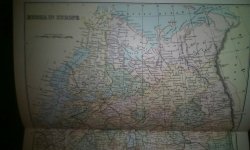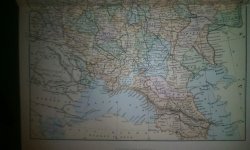A while ago, I wrote an article on the age of the Aral Sea. In the process, I noticed that the city of Samarkand was not properly placed on our contemporary maps. In other words, our contemporary Samarkand is not the same Samarkand from where Tamerlane used to rule over his Timurid Empire. These two locations are not even close to each other.
The Aral Sea is indeed much younger than we are being told. Sounds like the Aral Sea formed in or around 1719, according to this 1739 source.

The above text also tells us that river Oxus (we are told it's Amu Darya today) did some serious shenanigans with its course. The most important part about the Oxus river is that it used to flow into the Caspian Sea in mid-1600s. As you can see below, today, Amu Darya (Oxus) flows into the Aral Sea.
The general area depicted below is a truth seeker's gold mine. Some facts you inevitably end up discovering, cast some serious doubt on the qualification of professional historians and archeologists covering the area. They even created this fictional Oxus civilization.
My best overlaying attempt produced the following image.

Naturally, I figured that coastal cities of the 1600s Caspian Sea should still be present in some shape or form.

The below video can give you an idea on the narrative compliant version of the events in the area outlined above.

And while the Dutch East India Company had no apparent interest in the Caspian region, I doubt that they would rely on some bogus and inaccurate maps in their colonization endeavors.

1 degree of Latitude = 69 miles:
On the current today's map, we have approximately (66.5 - 48) 18.5 degrees of Longitude between Astrakhan and Samarkand.

Where was Samarkand in 1635?When we use distances established using the 1635 map, the original Samarkand should be located (approximately of course) at the following coordinates:

KD: Where am I wrong? And if I'm not...
The Aral Sea is indeed much younger than we are being told. Sounds like the Aral Sea formed in or around 1719, according to this 1739 source.
The general area depicted below is a truth seeker's gold mine. Some facts you inevitably end up discovering, cast some serious doubt on the qualification of professional historians and archeologists covering the area. They even created this fictional Oxus civilization.
- The Bactria - Margiana Archaeological Complex (aka the Oxus Civilization) is the modern archaeological designation for a particular Middle Bronze Age civilization of southern Central Asia also known as the Oxus Civilization.
- The civilization's urban phase or Integration Era, was dated in 2010 by Sandro Salvatori to c. 2400–1950 BC, but a different view is held by Nadezhda A. Duvoba and Bertille Lyonnet, c. 2250–1700 BC.
- The Oxus Civilization
- That is using the conventional chronological time line.
My best overlaying attempt produced the following image.
The below video can give you an idea on the narrative compliant version of the events in the area outlined above.
Willem Guilielmus Janszoon Blaeu
For my research, I chose this map, allegedly produced by Willem Blaeu around 1635. There are other similar looking maps out there, but this one stands out. Willem Blaeu was a Dutch cartographer who died in 1638. If we are to believe the narrative, then there is nothing more important in his bio than this line here:- In 1633 he was appointed map-maker of the Dutch East India Company.
- This is why the chosen map stands out.
- Willem Blaeu - Wikipedia
- Dutch East India Company - Wikipedia
And while the Dutch East India Company had no apparent interest in the Caspian region, I doubt that they would rely on some bogus and inaccurate maps in their colonization endeavors.
Latitude and Longitude
Not trying to insult anyone's intelligence here, but do have to cover this Geographic Coordinate System. It's gonna be easier to explain certain things as we go.
- A degree of latitude, one degree north or south, is about the same distance anywhere, about 69 miles (111 kilometers).
- A degree of longitude, one degree east or west, is a different distance at different points on the globe. At the equator, a degree of longitude is the same as a degree of latitude, about 69 miles (111 km). But it decreases as you move closer to the north or south pole.
- For the purpose of this article 1 degree of longitude equals
- 52 miles at 40 degrees north of Equator.
- 50 miles at 43 degrees north of Equator.
- 48 miles at 45 degrees north of Equator. - the one I'm actually gonna use.
A Prime Meridian
While everyone appears to have no issue with where the Equator is, the Prime Meridian had to be agreed upon. Today we use the Greenwich Meridian. Back in the day there were tons of different Prime Meridians. In this article we will utilize the Prime Meridian used by Willem Blaeu.- 31°06′W - Corvo Island for Willem Blaeu map.
- Astrakhan: 46°21′00″N - 48°02′06″E
- Samarkand: 39°39′17″N - 66°58′33″E
1635

On the above map, we have approximately (102-77) 25 degrees of Longitude between Astrakhan and Samarkand.
- 25 degrees x 48 miles = 1200 miles west to east distance in 1635.
Today

On the current today's map, we have approximately (66.5 - 48) 18.5 degrees of Longitude between Astrakhan and Samarkand.
- 18.5 degrees x 48 miles = 888 miles west to east distance in 2023.
- Approximate vertical, south to north latitudinal distance differential you can calculate yourself.
- On today's map, we have approximately 7 degree difference between the two.
- On the 1635 map we have 2.5, may be 3 degrees separating Astrakhan and Samarkand.
- The 1635 map's latitudinal scales do not go that far north.
- At 69 miles per degree... you be the judge.
Where was Samarkand in 1635?
- ~ 45 degrees North and ~ 73 degrees East.
- Obviously, the margin of error is 69 miles north-south, and 48 miles east-west.
KD: Where am I wrong? And if I'm not...
- What not so ancient city is impersonating Samarkand today?
- What city is impersonating Bukhara?
- What happened to the original cities in question?



